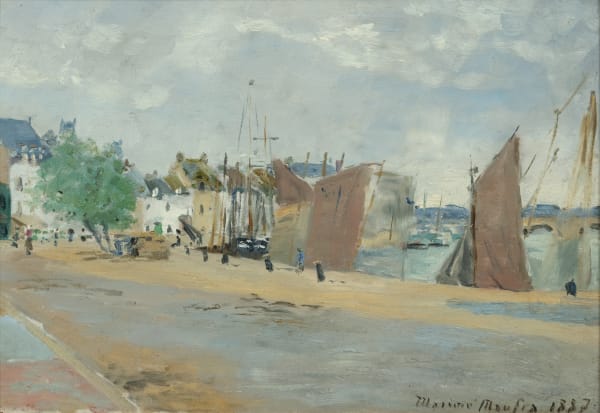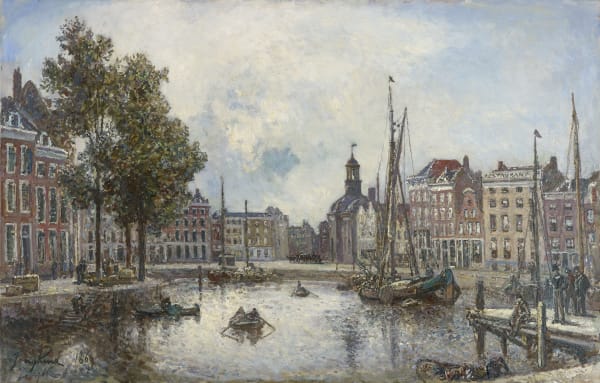Maxime Maufra French, 1861-1918
Maxime Maufra, born 1861 in Nantes, Western France, began painting at the age of 18 encouraged by the Leduc brothers and Charles Leroux, artists who were residing in his hometown at the time. Maufra’s parents were reluctant to allow him pursue a career as an artist, and so he spent his youth working for the family business, painting in his spare time from 1884 to 1890.
In 1883, Maufra was sent to London by his father to receive specialist training in business. Maufra took the opportunity to visit the National Gallery, where he discovered the works of J.M.W Turner. The experience proved revelatory for Maufra, who was inspired by Turner’s use of dramatic light and expressive colour would later influence Maufra’s artistic approach.
On his return to France, he discovered the work of the Impressionists and exhibited at the Paris Salon of 1886. By 1890, Maufra, now a full-time painter, left Nantes for Pont-Aven in Brittany, where he met Paul Gauguin and Paul Sérusier, a formative experience that would have a definitive impact on his style.
Maufra had his first solo exhibition in Paris in 1894, at Le Barc de Boutteville, for which Gauguin designed the poster. He subsequently exhibited with Paul Durand-Ruel, who would remain his dealer throughout his career.
On his return to Paris in 1893, he was the first painter to take up residence in the well-known Bateau-Lavoir in Paris, where later Cubist artists including Pablo Picasso would take up residence.
As a member of the Pont-Aven School, Maufra embraced sensitive depiction, characterised by the use of flat forms denoted by energetic outlines. Maufra often focused on marine subjects such as the coastal landscape, ships and ports. Contrary to many artists working at the time Maufra did not use pure colour or symbolic forms, but remained attached to the use of short, delicate brushstrokes inherited from Impressionism. Maufra was preoccupied with attaining both reality and intensity in composition, continually oscillating between a realistic and a symbolic approach to landscapes painting. This dichotomy is illustrated in his masterpiece Vue du Port de Pont-Aven, executed in 1893.
While Maufra retained the influence of Synthetic techniques - particularly an interest in depicting volume through balancing of line and colour - from 1894 onwards, the artist along with Henry Moret, would share a preference for light and clarity, embarking on a more naturalistic approach to landscape, eventually paving the way for more expressionist compositions.
Maxime Maufra’s works are included in numerous public collections, including the National Gallery of Art, London; The Cleveland Museum of Art, Cleveland; Musée des Beaux-Arts de Quimper, Quimper.
-
 Maxime MaufraCalme d’été, baie de Douarnenez, 1899Oil on canvas60.3 x 73 cm
Maxime MaufraCalme d’été, baie de Douarnenez, 1899Oil on canvas60.3 x 73 cm
23 5/8 x 28 3/4 inchesSigned and dated lower right -
 Maxime MaufraLes bords de l’Elorn, Plougastel-Daoulas, 1897Oil on canvas60 x 73 cm
Maxime MaufraLes bords de l’Elorn, Plougastel-Daoulas, 1897Oil on canvas60 x 73 cm
23 5/8 x 28 ¾ inchesSigned and dated lower right Maufra 97 -
 Maxime MaufraLa Côte Bretonne; Falaises aux environs de Saint Brieuc, 1893Oil on canvas66.5 x 60 cm
Maxime MaufraLa Côte Bretonne; Falaises aux environs de Saint Brieuc, 1893Oil on canvas66.5 x 60 cm
26 ¼ x 23 ¼ inchesSigned and dated lower right Maufra 93 -
 Maxime MaufraVue du Port de Pouliguen, 1887Oil on panel23.5 x 34 cm
Maxime MaufraVue du Port de Pouliguen, 1887Oil on panel23.5 x 34 cm
9 x 13 ¼ inchesSigned and dated lower right Maxime Maufra 1887
-

TEFAF Maastricht 2019
16 - 24 Mar 2019For TEFAF Maastricht 2019, Stoppenbach & Delestre is pleased to present a selection of 19th & 20th-century French artworks such as works by Louis Valtat, Henry Moret, Gustave Loiseau, Armand...Read more -

TEFAF Maastricht 2018
10 - 18 Mar 2018For the 2018 edition of TEFAF Maastricht, Stoppenbach & Delestre is pleased to present a curated exhibition entitled Brittany from the Pont-Aven School to Post-Impressionism, which will include 15 works,...Read more






